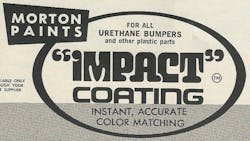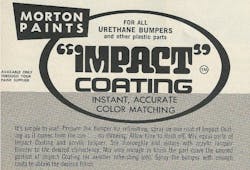YesterWreck – The Column: The Collision Repair Industry – 1970 – 1979
Editor's Note: This is the eighth in a FenderBender-exclusive series, excerpted from Ledoux’s book, YesterWreck: The History of the Collision Repair Industry in America, available here. Find the rest of the series here.
Overview
The 1970s were a turbulent time in America. Students died at Kent State. Soldiers continued to die in Vietnam. And the government saw fit to ban cigarette advertising on TV because smoking was bad for everyone’s health. Disco dancing and leisure suits were “in,” and hippies were out.
Auto design took a back seat to innovation to meet federally mandated clean air and mileage standards. The term “CAFÉ standard” entered the automotive lexicon; so did the term “sticker-shock” as auto prices soared.
Ford Pinto gas tanks were exploding on impact and GM swapped Oldsmobile, Buick, and Pontiac engines for Chevy V8s – and didn’t tell anyone – until they were discovered, causing general distrust of the auto industry.
The decade saw two gasoline shortages, sending the economy and the auto industry reeling. Consumers wanted fuel efficient cars. Detroit was short on “econoboxes.” Imports were small, stylish, and fuel efficient, but also commanded sticker price or higher in the wake of long, frustrating gas lines.
The spiraling costs of petroleum products not only hurt consumers at the gas pump but also affected the collision industry. According to their company history, during the 1970s, DuPont was buffeted by a deep depression and high costs of raw materials. By the mid-1970s, 70% of DuPont products used petroleum-based materials, driving refinish costs higher. Inflation was everywhere.
Repairing Cars in the Wild West
Some who were in the collision repair business in the early ‘70s describe it as the “Wild West” era, where many things went on that were not talked about in a business conversation, and no one would attest to, but went on just the same. In a 2003 collision trade magazine article, a former claims adjuster from the 1970s noted that it was not uncommon back then for him to find envelopes full of $100 bills stuffed under his car’s visor, left there by the shop owner as an incentive to keep cars coming to his shop, and to keep treating him right on the estimates. In an unrelated piece, another former shop owner noted that he applied for a job as an adjuster with a small regional insurance company. He was hired for the job and then told what his salary would be. He complained that based on those figures, he couldn’t even pay his mortgage. The hiring agent from the “home office” just smiled and said “I’m sure you’ll find some way to make ends meet,” insinuating that there was money to be made elsewhere in the system in a less –than-above-the-board manner. A few years later, that same company was firing adjusters for stealing.
The Infamous Two-Man Shop
In the 1970s, the number of shops continued to grow, fueled by younger techs who did not want to conform to the rules of an existing shop, or didn’t like the work they were getting, and decided to start their own shop. Angry, and determined to “get back” at their former employer, they found a small garage, hung a sign, and opened for business.
Industry veteran Tony Lombardozzi explains, “When these guys left, they either took someone with them or very quickly realized they needed some help and became a two-man shop. Then they went to all the former shop’s insurance contacts to tell them, to get their business, they would charge $2 per hour less than their previous shop. Then the work started to roll in, but in the days before job-costing, those two guys never knew if they were making any profit or not. If they had money left in the checkbook at the end of the week, it was a good week. Subsequently, many of them didn’t last.”
However, some of these shops exist today (in 2017, the time of this book’s writing) operating on a shoestring and “flying under the radar.” Lombardozzi explains, “There is always someone looking for a cheap and fast collision repair, not caring if OE procedures are observed or not. And there is always a small, out-of-the-way shop that is willing to provide it, and maybe even save their deductible for them. But the cost of doing business is now so high, and in the wake of the John Eagle decision, the liability is so high, it’s only a matter of time before these little shops disappear.”
MSOs, and PBEs
The 1970s saw the seeds sown for what would become the model for 21st century collision shops. Before the days of ABRA, CARSTAR and Caliber, Pittsburgh industrialist Ward Wickwire signed the first franchising agreement to open an American Way International body shop in Pittsburgh. The agreement carried an option for franchised shops throughout Pennsylvania. Wickwire fully believed that the AWI business model would solve many of the industry’s problems.
AWI never became a household word or was nationally recognized, but this period would give rise to those who were. In 1972, Anthony A. Martino opened his first auto painting shop in Wilmington, Delaware. Using the first letter of his last name, and the first letter of his first and middle name, he called his new business Maaco Auto Painting. He soon began to open additional shops providing a good overall paint job at a reasonable cost, and by 1977, he had almost 200 locations. Martino died in January 2008 and in October, the company he founded was sold to Driven Brands of Charlotte, North Carolina, a holding company which also holds Meineke Car Care Centers and Econo Lube, among others.
Innovative ideas were popping up all over the place. Early 1972 saw a short trade magazine article suggesting that a car should be totally torn down to write a complete and correct damage estimate. This is perhaps the first time this was novel concept at the time was mentioned in a trade magazine.
Industry associations were growing in numbers, strength, and savvy. State and regional associations were popping up all over the place and joining with national associations. The industry’s voice was getting louder.
The 1970s also saw the recognition of the paint, body, and equipment (PBE) jobber by the Automotive Service Industry Association (ASIA) as a valid entity for the industry. They were highlighted at a 1972 trade show sponsored in part by ASIA. ASIA defined a PBE jobber as a store for whom at least 70 percent of their sales come from paint, abrasives, tape, collision repair equipment and the like sold to body shops.
Based on a survey conducted by ASIA leader Russ Higgens, within the last decade, the number of stores that met those criteria had grown from around 100 to 1,500. Of the roughly 25,000 full line automotive parts jobbers in the U.S., about 15,000 carried paint and body supplies to an extent, but only 2,000 or so actually promoted the sales of these items. (Traditional parts jobbers had been carrying paint and related products since the 1930s.) Higgens noted that the stores that specialized in PBE products earned a gross profit on those products of 29.3%, somewhat lower than the 32.3% earned by full-line jobbers who carried mostly mechanical parts and dabbled in paint and collision products as a sideline. However, the good news in 1972 was that PBE jobbers tended to turn their stock faster than full-line jobbers. PBE jobbers turned their stock seven times per year, while the full-line jobber was lucky to turn their stock four times per year. ASIA’s Higgens committed to work to help support the PBE jobber segment of the market.
"Dukes of Hazards"
In the days before we as a country and as a culture grew environmentally conscious, body shops had some horrendous ways to get rid of highly toxic waste products. Many times, leftover paint was stored for a while until it gelled, then it was thrown in the trash. Other times it would be thrown on wastepaper and burned. Some shops threw all waste products, including paint, thinner, and primer, into a 55-gallon drum. When the drum was full, it was dumped off in some remote area – sometimes with the drum and all, or sometimes just the contents were dumped and the drum reused. Some poured the barrel’s contents on the gravel parts of their lots or driveways to keep the dust down.
The Resource Conservation and Recovery Act (RCRA), enacted in 1976, was the principal federal law in the United States governing the disposal of solid waste and hazardous waste, which essentially ended shops’ practices of indiscriminate waste dumping.
And if managing hazardous waste wasn’t enough to give shop owners a headache, OSHA entered the industry lexicon as well in the early ‘70s. The Occupational Safety and Health Act of 1970 took effect April 28, 1971. An article in an August 1971 industry trade journal notes that shop owners must comply with federal inspectors who are able to stop in and inspect their shop at any time, with fines for safety infractions reaching as high as $10,000. The article suggests 10 areas where inspectors are liable to look for safety hazards. The article also notes that the federal government is poised to “plague shop owners.” Shop owners now had something else to keep them awake at night.
Excerpted from Ledoux’s book, YesterWreck: The History of the Collision Repair Industry in America available here.
About the Author
Gary Ledoux
A native of New Hampshire, Gary Ledoux retired in 2017 after a 48-year career in the automotive industry. For 18 years, he worked in various capacities in numerous car dealerships in New Hampshire. In 1988, Gary began his career with American Honda, eventually serving as the assistant national manager for American Honda’s Collision Parts Marketing Department, and was instrumental in launching Honda’s certified body shop program. He was very active in the collision repair industry, serving on various Collision Industry Conference (CIC) committees and as a three-time chairman of the OEM Collision Repair Roundtable. Today, Ledoux is a freelance writer splitting his time between his Florida home and vacation property in South Carolina. In the summer of 2018, he published his fifth book, YesterWreck: The History of the Collision Repair Industry in America.



